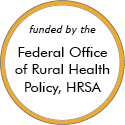Rural Project Examples: Health workforce education and training
Evidence-Based Examples
Thomas Jefferson University's Physician Shortage Area Program
Updated/reviewed September 2025
- Need: More rural doctors were needed in multiple states. In Pennsylvania, nearly half of the state's physicians practice in just three large metropolitan counties.
- Intervention: Sidney Kimmel Medical College at Thomas Jefferson University established the Physician Shortage Area Program (PSAP) in 1974 to recruit and support students who are from rural backgrounds and who wish to practice in rural communities.
- Results: Approximately 80% of PSAP alumni have remained in rural family medicine for at least 20 to 25 years after graduation.
Effective Examples
Wyoming Trauma Telehealth Treatment Clinic
Updated/reviewed April 2025
- Need: To provide psychotherapy to survivors of domestic violence and sexual assault.
- Intervention: University of Wyoming psychology doctoral students provide psychotherapy via videoconferencing to crisis center clients in two rural locations.
- Results: Clients, student therapists, and crisis center staff were satisfied with the quality of services, and clients reported reduced symptoms of depression and PTSD.
OHSU Rural Surgery Training
Updated/reviewed October 2024
- Need: General surgeons are needed in rural communities.
- Intervention: Oregon Health & Science University (OHSU) is sending residents to complete a general surgery rotation in rural southern Oregon.
- Results: 19 graduates of the rural residency program are currently practicing in a rural setting. The residents remain more likely than other OHSU residents to enter general surgery practice and to serve in a community of fewer than 50,000 people.
Rural Medical Education Program at University of Illinois College of Medicine Rockford
Added October 2023
- Need: To recruit and train medical students who are committed to choosing rural practice.
- Intervention: An add-on curriculum that includes seminars, field trips, and clinical rotations in rural and underserved areas.
- Results: 436 students have graduated from the RMED program between 1997 and 2023, with 65% of program graduates practicing in towns of less than 50,000 people.
MU AHEC Summer Community Program
Updated/reviewed September 2023
- Need: Lack of healthcare providers, specifically physicians, in rural Missouri.
- Intervention: Rising second-year medical students at University of Missouri's School of Medicine are given the opportunity to participate in a clinical program in a rural community setting.
- Results: Almost half of the participants from 1996-2010 chose to practice in rural locations upon graduation.
Livingston County Help For Seniors

Updated/reviewed May 2020
- Need: Meeting the health needs of geriatric patients in rural Livingston County, New York.
- Intervention: The Help for Seniors program was developed and using its 'vodcasts,' local EMTs were trained in geriatric screening methods and health needs treatment.
- Results: In addition to developing a successful model for educating EMS personnel, the program screened over 1200 individuals and identified various risks among the geriatric population.
Promising Examples
TUSM-MHMMC Program Longitudinal Integrated Clerkship

Updated/reviewed April 2024
- Need: To fill vacant medical positions in Maine's rural medical facilities.
- Intervention: The Tufts Maine Track LIC program offers clerkships in rural medical facilities, exposing medical school students to the positives and possibilities that rural practices have to offer.
- Results: The program has seen an increase in students' interest in practicing in rural Maine. The majority of participants have pursued medical careers in one of the six core specialties studied during their clerkship.
Other Project Examples
Wisconsin Collaborative for Rural Graduate Medical Education
Updated/reviewed November 2025
- Need: Primary care physicians in the rural areas of Wisconsin.
- Intervention: A GME collaborative and technical assistance center that provides leadership, GME expertise, and support for expanding rural graduate medical education in Wisconsin.
- Results: The collaborative expanded rural graduate medical education opportunities which now include over 30 rural-focused residency programs. There are several GME opportunities in specialties ranging from family medicine to surgery, obstetrics/gynecology, psychiatry, internal medicine and more.
Implementation of a Nursing Veterans' Initiative to Transform Education (INVITE)

Updated/reviewed September 2025
- Need: To support rural veterans pursuing a career in nursing.
- Intervention: The INVITE program improved the curriculum and reworked admission requirements to better support veteran students' experiences in the College of St. Scholastica undergraduate nursing program.
- Results: The number of veterans pursuing nursing has more than doubled since program implementation, and all students have reported an increased interest in serving rural communities.
McPherson Hospital High School Internship Program
Added September 2025
- Need: To provide high school students with hands-on health care experience while filling high-need roles in a rural hospital.
- Intervention: An internship program for high school students at McPherson Center for Health in McPherson, Kansas.
- Results: More than 30 students have participated in the program since 2023, seven of whom have become part-time or full-time employees at the hospital as a result.
For examples from other sources, see:
